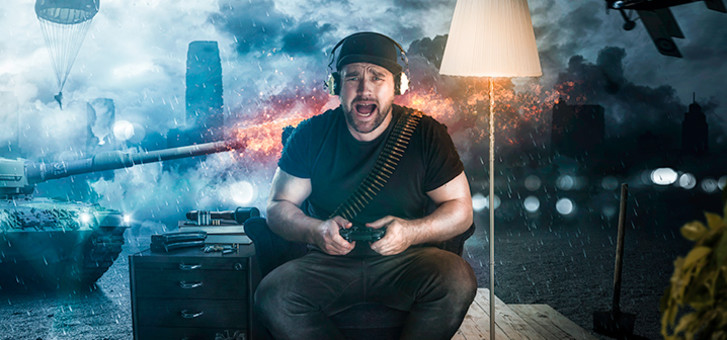Forbes Magazine reports that in 2017 the best-selling video game worldwide was Call of Duty: WWII.1 It’s the fourteenth in a best-selling franchise of “first-person shooters” that gives players the opportunity to take on the role of a US Army private in some of the bloodiest encounters of World War II. The R18+ game also includes an alternate storyline where players can use their skills against an undead army of Nazi zombies.
Box Office Mojo reports that in the same year international cinema-goers spent more than $US9.9 billion on tickets to just the top 10 films.2 The list includes everything from Star Wars: The Last Jedi to Beauty and the Beast. However, every title in the top ten has this in common: violence is critical to the progression of their storylines.
On the small screen, it was a similar year. Ranking the most popular television show for 2017 was a battle between Game of Thrones and The Walking Dead. The former chronicles the bloody battles between the claimants to the fictional throne of Westeros. The latter pictures our world overrun by flesh-eating zombies. Parrot Analytics measured a complex mixture of ratings data, social media chatter, blogging, illegal pirating and half a dozen other factors to gauge not simply what we were watching, but what we were thinking about. Game of Thrones claimed the crown, but it was hardly a stand-out candidate. Fifteen of the world’s top 20 TV shows also revolved around persistently violent narratives.3
This is just a sampling of the peaks of electronic entertainment that we indulged in over the past 12 months. It doesn’t take into account mobile viewing, app-based games or online experiences like World of Warcraft and League of Legends. What it does do, though, is shine a light on the settled place violence occupies in the ways we choose to kill time. Douglas Gentile, a developmental psychologist and one of the world’s leading scientific experts on the positive and negative effects of media on children, adolescents and adults, has this to say about our fascination with violent entertainment: “Realising when a diversion has gotten out of control is one of the great challenges of life.”4
Have we realised the danger? Yes, and quite a long time ago, in fact.
There is no shortage of voices on the internet who would like to make film and television the culprits for all manner of social changes, including an increase in violence as a whole. A favourite “proof” is to point to the personal media collections of serial killers and let the imagination fill in the gaps logic cannot cross. Strictly speaking, it’s impossible to draw a direct line of causality between exposure to violent imagery and someone’s proclivity for violent behaviour—there are too many other factors at play in an individual’s life. However, our sensitivity to violence is another matter entirely.
As far back as 2003, experts warned that our viewing population was becoming less concerned about violence in entertainment, even as the amount of violent and explicit material on television climbed. Violence deadens the conscience in much the same way that binge-eating dulls the palate: the more we have, the less we appreciate what we’re digesting. However, long-term exposure to a particular view of the world doesn’t just lessen our defences, it can rewire them altogether.
Every time we master a skill or learn a lesson, we lay down a neural pathway in our brain—a settled short-cut to a series of responses, if you like. Neurologists have long known that these pathways can actually be rewired by sustained exposure to particularly imagery: “The brain is constantly being shaped, wittingly and unwittingly, by environmental forces that impinge on organisms,” says an article in the academic journal, Nature and Neuroscience. “The circuitry that has been implicated in social and emotional behaviour appears to be importantly shaped by experience, and early experience in these domains is likely involved in governing differences among individuals in their vulnerability or resilience to future adversity.”5
In the case of pornography, constant exposure to sexualised content produces clear, physical results. Our brain’s definition of sexual stimulation is changed, and so our physiological responses follow. Thus porn can lead to addictive, even self-destructive behaviours. In the case of violence, this “brain surgery by TV remote” can alter our perceptions of life as a whole.
At the society-wide level, the industry’s rush to titillate audiences with violent material results in something sociologists refer to as the “cultivation effect”.6 People start to see the world differently. For example, when we hear “Ethiopia, Sudan, Syria,” what images come to mind? Did any of them involve starving people, or gunmen and militia out of control? Many viewers’ perceptions of Africa and the Middle East are exclusively created by news coverage of conflicts and disasters. Entertainment products further enforce this selective presentation of certain countries as law-less environments.
The cultivation effect diminishes our shock, even our sympathies. Accordingly, the violent outrages of Tom Clancy’s black ops teams or MI6’s double-0 agents begin to look completely appropriate. Before too long the cycle reverses, with fantasy violence changing what we consider appropriate behaviour in real life, and dulling our response when we hear governments use terms like “proportionate response” and later, more accepting of strong-arm solutions to perceived threats and less sensitive to others’ needs.
Honestly, though, you and I don’t need studies to confirm that prolonged exposure to negative imagery has a damaging effect. I’m sure I’m not the only person who has seen violent passions subtly change the people around them. I have friends whose relaxed attitude to TV aggression regularly colours their language, inflames their tempers and increases the distance they perceive between themselves and others. It might surprise you to know, though, that this is not a new problem.
Some 2000 years ago the Apostle Paul, a leader in the early Christian church, expressed sincere concern about the transformative power of distractions and diversions. His advice to believers in the ancient city of Philippi was to be careful where they allowed their minds to rest: “Brothers and sisters, whatever is true, whatever is noble, whatever is right, whatever is pure, whatever is lovely, whatever is admirable—if anything is excellent or praiseworthy—think about such things . . . and the God of peace will be with you” (Philippians 4:8–9).
In effect, this early passage from the Bible is all about producing positive brain pathways shaped by constant exposure to the things God commends, rather than those that affirm a darker, less compassionate view of life.
Though the world might in many cases prove to be a violent, untrustworthy place—first century Christians certainly found it to be so!—that realisation was not meant to rob us of our peace. In fact, Jesus told His followers that the answer lies, not in cultivating a more optimistic view of our fellow man, but in ensuring we fear the right things: “Do not be afraid of those who kill the body but cannot kill the soul. Rather, be afraid of the One who can destroy both soul and body in hell” (Matthew 10:28).
The Bible says that fearing God is the beginning of wisdom, not simply because He remains in control of those things that might threaten our bodies, but because only He can save us from eternal destruction. We will always benefit from exercising more control over our intake of those vio-lent pastimes that threaten to make our view of the world more anxious and less sympathetic to suffering. But the answer isn’t to remove fear altogether. Rather, we need to embrace a healthy fear—a reverence of real power—that leads to ultimate certain security.
1. E Kain, “The Best-Selling Video Games Of 2017 (So Far),” Forbes Magazine, https://www.forbes.com/sites/erikkain/2017/12/16/the-best-selling-video-games-of-2017-so-far/#2c7f08a8ab2b
2. Box Office Mojo, http://www.boxofficemojo.com/yearly/chart/?view2=worldwide&yr=2017
3. J Nededog, “Ranked: The 20 most popular TV shows of 2017,” Insider, http://www.thisisinsider.com/most-watched-tv-shows-world-parrot-analytics-2017-12#5-prison-break-fox-16
4. DA Gentile (2003). Media Violence and Children: A Complete Guide for Parents and Professionals, Praeger.
5. R Davidson & B McEwen, “Social influences on neuroplasticity: stress and interventions to promote well-being,” Nature Neuroscience, Vol. 15, No. 5, May 2012, p. 689.
6. http://cultivationanalysisrtvf173.pbworks.com/f/ViolenceonCollege+JJ.pdf






